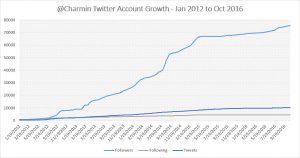Think Like a Troll, Act Like a Brand: How @Charmin organically grew its Twitter account to superstar status
Twitter is a tough place to be for anyone; large brands are no exception. But in addition to the cynicism, it has to balance pleasing customers and its shareholders – a fine line to walk when you’re trying to grow an account.
But what if you were a large brand that sold toilet paper? What if all you had to tweet about was little pieces of paper that people use to wipe their asses with?
For Marie Bonaccorse Hackman and her small editorial team at Charmin, it was a playground of nutrient-rich material for tweeting.
“I was there from March of 2011 until probably, my last tweet was February or March of 2015 … I was there four years, I started the Twitter feed. I was there from its infancy…” Marie told me in an interview.
“We knew we were toilet paper, we had no qualms about it. We knew we were not inherently cool, but we knew that we could have a lot of fun with it.”
And have fun with it they did.
In that four years, the team organically grew their Twitter account from zero to 66k followers. While it was slow at first, the team grew the audience as much as 1192% year over year.
But not only did they experience explosive growth, they got picked up by almost every major media publication for their hilarious, snarky tweets.
How did they do it?
Here’s three key takeaways from Marie Bonaccorse Hackman – the woman at the helm during Charmin’s explosive (and award winning) growth on Twitter.
#1: Think Like a Troll; Act Like a Brand
First things first. Bonaccorse Hackman needed a motto in order to thrive on one of the most hateful social networks out there.
“My personal motto that I created is ‘Think like a troll, act like a brand,’” she claimed.
“We knew we were toilet paper, we didn’t care. If you didn’t like us, that was okay. We weren’t trying to buy your love or we weren’t trying to buy your affection or your follow. We just wanted to bring a little bit of enjoyment from the bathroom humor, from the actual toilet paper.”
#2: Don’t Try to Buy Affection
The second piece of the @Charmin team’s strategy was to always make sure they weren’t selling. According to Marie, the whole point of the Twitter account was to make people remember Charmin when they were walking down the toilet paper aisle.
“If you’re going down the toilet paper aisle, you can remember us fondly and you can sit there and say, ‘Hey, I remember that tweet that made me laugh.’ So it’s very top of mind and that is how we wanted to create that rapport and that community.”
However, staying focused on delivering a great social experience for their customers was practical objective of the account.
“I think it’s fundamental to understand social media is social. It is about human engagements, it is about human interaction and conversation. Yes, we all want to drive cases and sales and everything like that. But if you do not understand that it is about sharing these small bite size, snack-able moments that everyone can relate to, then don’t bother being on [social media], and just do a little bit of paid on Facebook,” Bonaccorse Hackman said.
#3: Create a Brand Personality and Stick to It
Thirdly, Bonaccorse Hackman and team were very intentional about sticking to their brand personality. There were two things the team kept in mind. The first was not confusing the brand personality with the actual person tweeting.
“There was me, Marie Bonaccorse and then there was Charmin. And making sure that I was very distinct with the equity which was playful instigator, we were not crass. Marie is not Charmin and Charmin is not Marie. We were two very separate entities even though there was a lot of overlapping. So when I was tweeting or creating content for the brand, I had to make sure that the focus was brand and not Marie.”
The second was to make the brand personality distinctive enough to be believable, but interesting enough to be sustainable. So going the Jean-Ralphio route might not the best approach.
“Just write your brand as a person. How are they with their humor? Are they a leader? Are they quiet? Do they have gravitas? Are they playful? Are they delightful?
Just 10 human characteristic descriptors that can translate to your brand that are not you and then from there that’s how you will take it, that’s how you will understand your brand. I don’t want to make things complicated for anyone, but obviously with what I do, I want to really dig down deep and make sure that we’re providing the best service in terms of who you are as a brand. But as a marketer who is doing this on a daily, just ten words and have it printed up on a piece of paper in front of you so that anytime you have to check or do a gut check, do that. Have a partner in crime that you can gut check off of, that is not associated with your brand per se.”
You might also like:
3 A/B Testing Case Studies from Smart Brand-Side Marketers
Benefits of CEO Twitter Use: Employee and customer engagement and investors’ willingness to invest
From 300 to 5,000 Twitter Followers in 3 Weeks: An interview with a growth hacker
Categories: B2C Marketing










